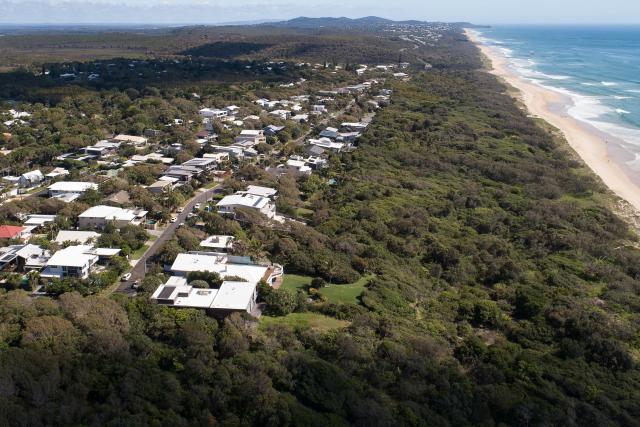Noosa Council’s encroachment policy needs real teeth if it is to meaningfully address the continued damage caused by encroachment in our coastal foreshores, said Marcus Beach Bushcare Association past president Judy Tulloch in an address to Noosa Parks Association Friday Forum last week.
Judy told a packed meeting that Council had recognised the extent of the problem but its local law applied only to vegetation damage and had insufficient ‘clout’ to deal with encroachments as defined in the Noosa Encroachment Policy.
Council developed a separate policy (Noosa Encroachment Policy 2023) from the Coastal Hazards Adaptation Plan (November 2021) and the Eastern Beaches Reserve Management Plan (August 2023) and the Noosa Encroachments Organisational Procedures 2023 guides the Councils management of encroachments into Council Reserves, parks and Council-managed land.
“It clearly defines what constitutes an encroachment,” Judy said.
“What we need is a zero-tolerance of encroachments, strong compliance measures and action by Council to enforce compliance. Without clear and well-communicated strong local laws and compliance measures, some property developers or home owners may see paying a fine for damage to vegetation as a small cost for the perceived improvement to the value of a property.
“This has gone on for too long without many people in the wider community realising what is happening. It needs to be out in the open so that the people of Noosa understand why the Council must act now to stop any further damage to Noosa’s Reserves and public spaces.”
Judy led a push for protection of nature reserves on the Eastern Beaches in 2022 when a petition was presented to Council.
“A resident approached the association concerned about an encroachment, and hadn’t had a response from Council,” she said.
“When I went down to have a look I was really shocked at what I saw – 300sqm had been cleared from the dunal area over 18 months.
“In May 2022 residents raised complaints with a huge garden that’d been built, trees cleared.
“When we first looked into this we couldn’t understand why nothing was being done. We’re still in the same place.
“In that petition we asked for this garden be restored to its former state, and for that be done at the expense of the owner not the ratepayers.
“Second thing we asked for was that Noosa takes a proactive zero tolerance approach to illegal appropriation of public land, degradation of public land through removal of native vegetation and unlawful dumping on public land.
“Council now has a definition of encroachment with all those things and a bit more.”
Judy told the forum encroachments went beyond the coastal reserve, could be small or large and include activities such as the dumping of rubbish, the creation of walking paths, clearing or trimming of native vegetation, planting of unsuitable plant species, laying of lawns and building of structures.
“Council needs to draw a line under this now,” Judy said.
“There used to be small houses on properties with a garden. Now people have big houses. They don’t have a backyard so they build a backyard in the reserve.
“It doesn’t reflect our values in Noosa. It takes years to regenerate. It’s done by people for personal or commercial gain. It’s unjust.
“This is people who are taking things that don’t belong to them for their own personal gain.”
Judy said in their research they found individual fines up to about $12,000 could be incurred under Local Law 4 but when the encroachment had the potential of adding hundreds of thousands of dollars to a property it was seen by some property owners as a good investment and the fine was ineffectual.
“That has to change. Local Law 4 has to change to reflect the policy that Council has developed,” she said.
Council’s Environmental Services Manager Ben Derrick told the forum Council had an issue with encroachments throughout the shire and its policy related to council-managed land across 183 bushland reserves, 3500 hectares of natural reserves and an additional 3500 hectares of road reserves.
“We’ve mapped all of our encroachments. We have a prioritisation plan. We have a working list,” he said.
Ben said communicating with residents, engaging them and education were Council’s first steps in returning encroachment areas back to the community.
“We identify each individual encroachment,” he said.
“Ecological restoration plans are developed, we engage with residents.
“Efforts up to that point are about working together leading to the creation of strong ecosystems. Sometimes that doesn’t work. If it comes down to enforcement then it’s up to the local law and working through the processes.
“We’ve seen in the past fines don’t work. If they don’t comply Council will come in and fix in.”
There are a number of grey areas when it comes to encroachments including the need of land clearing for fire breaks and emergency vehicle access, public rights of access, the construction of structures such as swimming pools on public land, and the onus of encroachments, particularly involving historic encroachments that may have been inherited by new owners.
Ben said while government works in a slow moving way the intent was to go into those places and bring them back to the community, the intent was to fix those up.
He said Council had last week advertised for a recovery officer to be tasked with addressing encroachment recovery over the next several years.
“This is essentially a decade long journey,” he said.
Judy called on all Council candidates for the upcoming election to commit to a strong regime of compliance when encroachments occur on Council land.
“Residents who are lucky enough to live on the boundary of a nature reserve can consciously choose to become custodians of the adjacent reserve, or create serious damage that has a negative impact on the natural environment,” she said.








